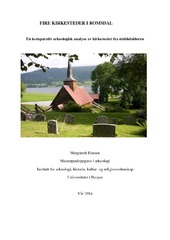| dc.description.abstract | Romsdalen in Møre og Romsdal county, at the western coast of Norway, has been the geographical scene for my masters’ thesis studying of four medieval church sites, at Veøy, Rødven, Hen and Grytten in three different administrative areas in the county. The aim has been to shed light upon the question of the location for the first churches chosen? Were the church sites located at older heathen ritual places or new places? Who built the earliest churches at Veøy, Rødven, Hen and Grytten church sites, and when? Was there a close relationship between farms and the churches, built as private churches at the farm, or as joint ventures in cooperation between farms within a certain district? Were they built as manifestations showing continuity to older pagan places? In order to illuminate these issues I have made use of different theoretical perspective and methodological approaches. The methods include archaeological visual landscape analysis when assessing the sites, and in order to gain a clearer understanding of why the places were chosen, and how people of the early Middle Age might have approached the areas both mentally and socio-economically. Were the communication lines important or were the early churches placed on remote places in the landscape. I have uses both cadasters from the 17th century and other sources retrospectively to assess the farms and their ability to build and maintain a church and a priest. Common Norwegian farmers in the Middle Age were hardly able and prosperous enough to build a church of their own household as private churches. Private churches, so-called høgendeskirker in Norwegian, must have been built by the elite within the communities. Congregation churches, so-called Norw. herredskirker, built and kept by a community were generally more centrally located – churches that generally later became parish churches. The archeologist Brit Solli who has excavated a site at the island and mediaeval central place Veøy discovered an early Christian graveyard there in 1990-92. This island with a strategic location in the fjord was a trading place and centre in Romsdal in the Middle Ages. According to its name it may also have been a heathen ritual place. The early dating of Christian graves to the middle of the 10th century is a very early manifestation of the Christianization in this part of Norway, probably initiated by the King. Whether heathen ritual traditions has had an impact on the choice of site, has also been taken into consideration when evaluation the timeframe for when a church could earliest have been built. The most important indicators are the archaeological finds of graves close by the church site. The topographical location has also been an important aspect, as well as a monumentality placed church may have signalized the power of the new religion and demonstrated the wealth and power of the church owner. My study has led to the conclusion that the church site at Veøy was most probably established in the late 900s on royal initiative, probably on an earlier heathen ritual place. The church sites at Rødven and Hen were probably established as private churches for people the farms and built around 1100, while Grytten seems to have been established late 1100, around 1200 at the latest, as a site for a parish church after the episcopal organization of parishes was established. | en_US |
| dc.description.abstract | I denne oppgaven har jeg analysert fire kirkesteder i Romsdal, Veøy, Rødven, Hen og Grytten. Jeg har stilt spørsmålet om på hvilk steder ble kirkene anlagt? Ble kirkene anlagt på steder hvor det hadde vært hedensk kult. Ble makt videreført gjennom plasseringen av de første kirkene? Eller ble kirkestedene valgt da sogneinndelingen ble gjennomført? Hvem anla dem og hvor? Jeg har brukt yngre kilder retrospektivt, kan man prøve å se lengre tilbake i tid. Jeg har også sett på arkeologiske spor, gårdsgrenser og navn på gårdene. konklusjonen ble at 2 kirkesteder, Hen og Rødven var mest sannsynlig høgendeskirker og satt opp før sogneinndelingen og Veøy kirkested var anlagtsent 900-tall og Grytten var anlagt i forbindelse med sogneinndelingen sent på 100-tallet. | en_US |
